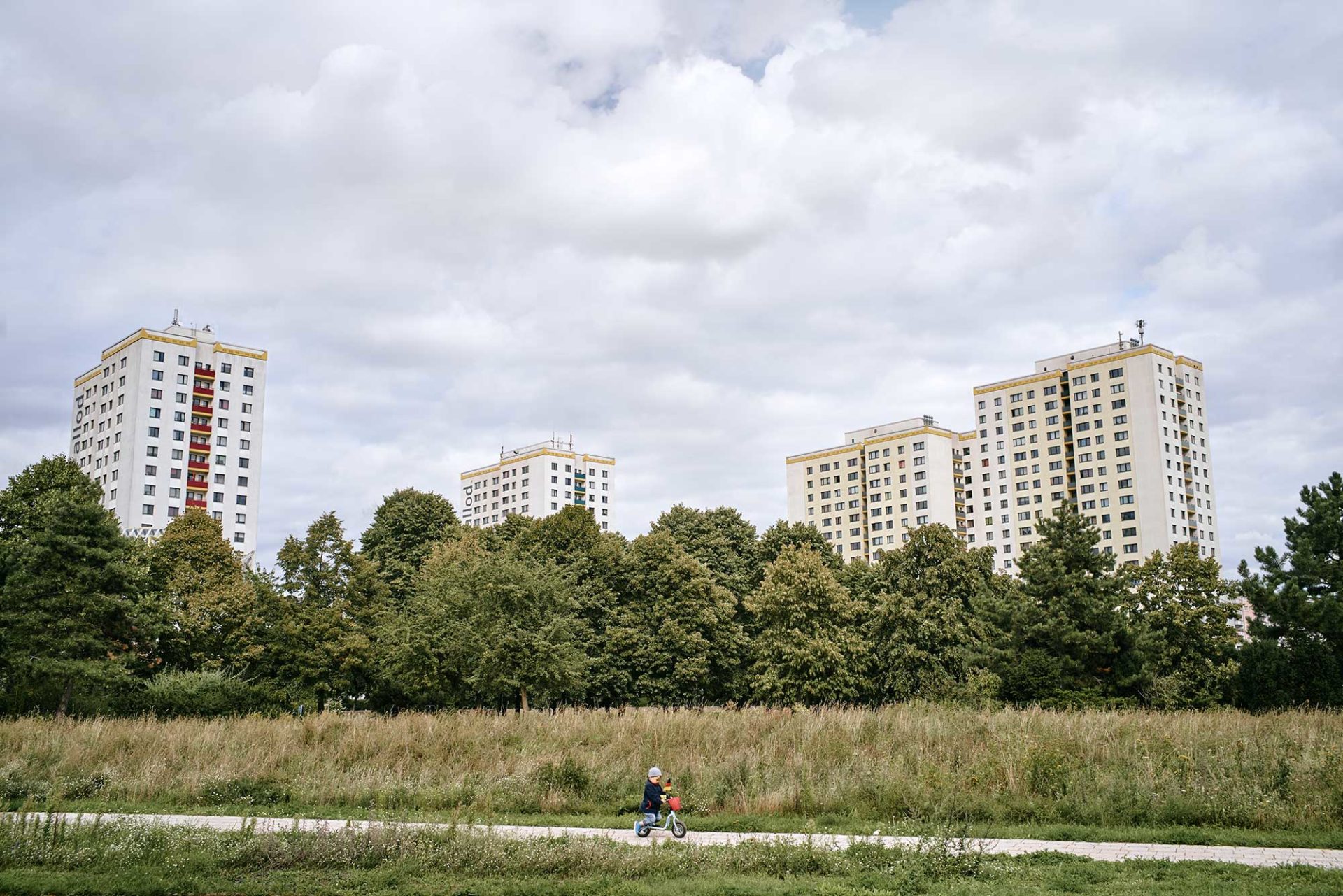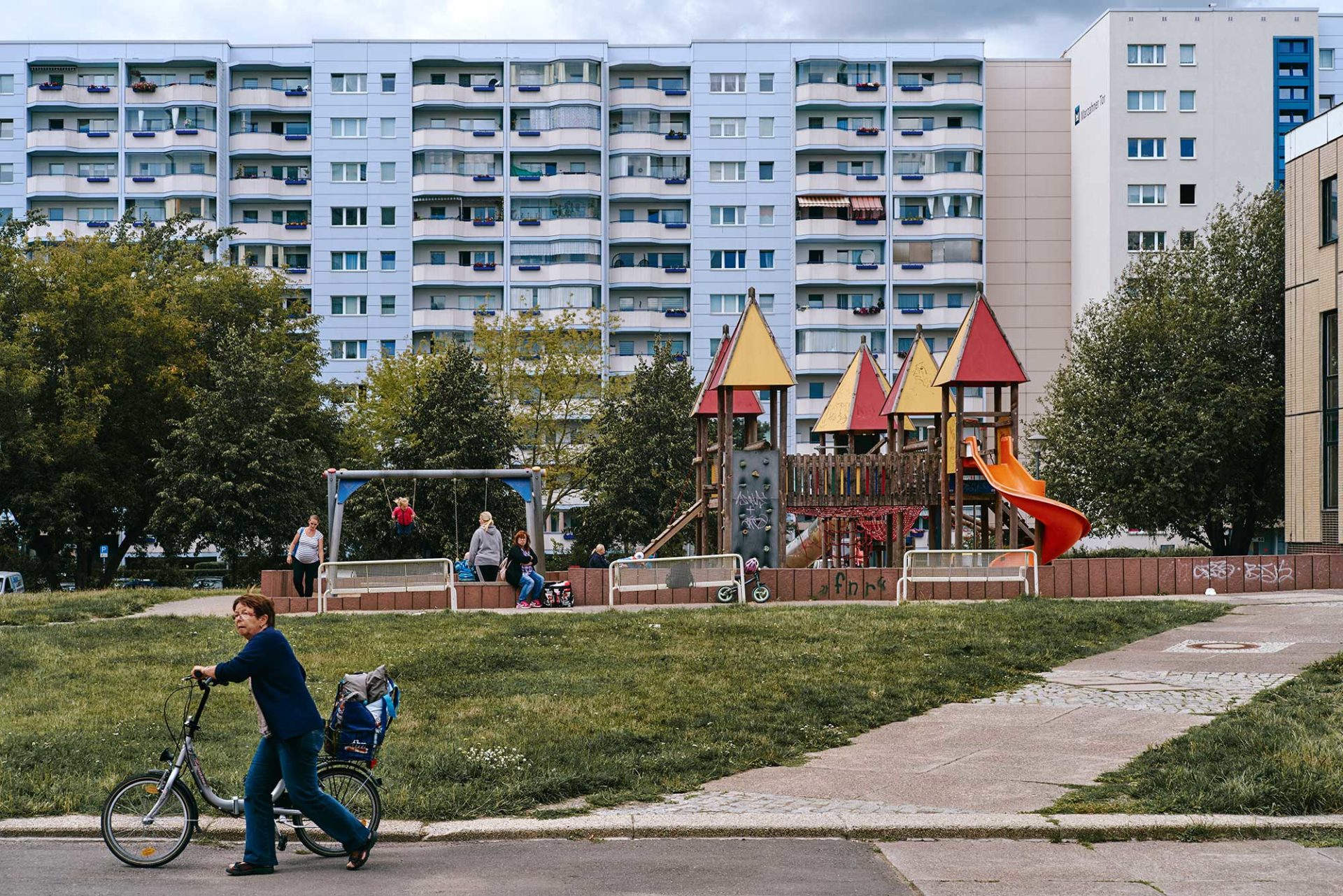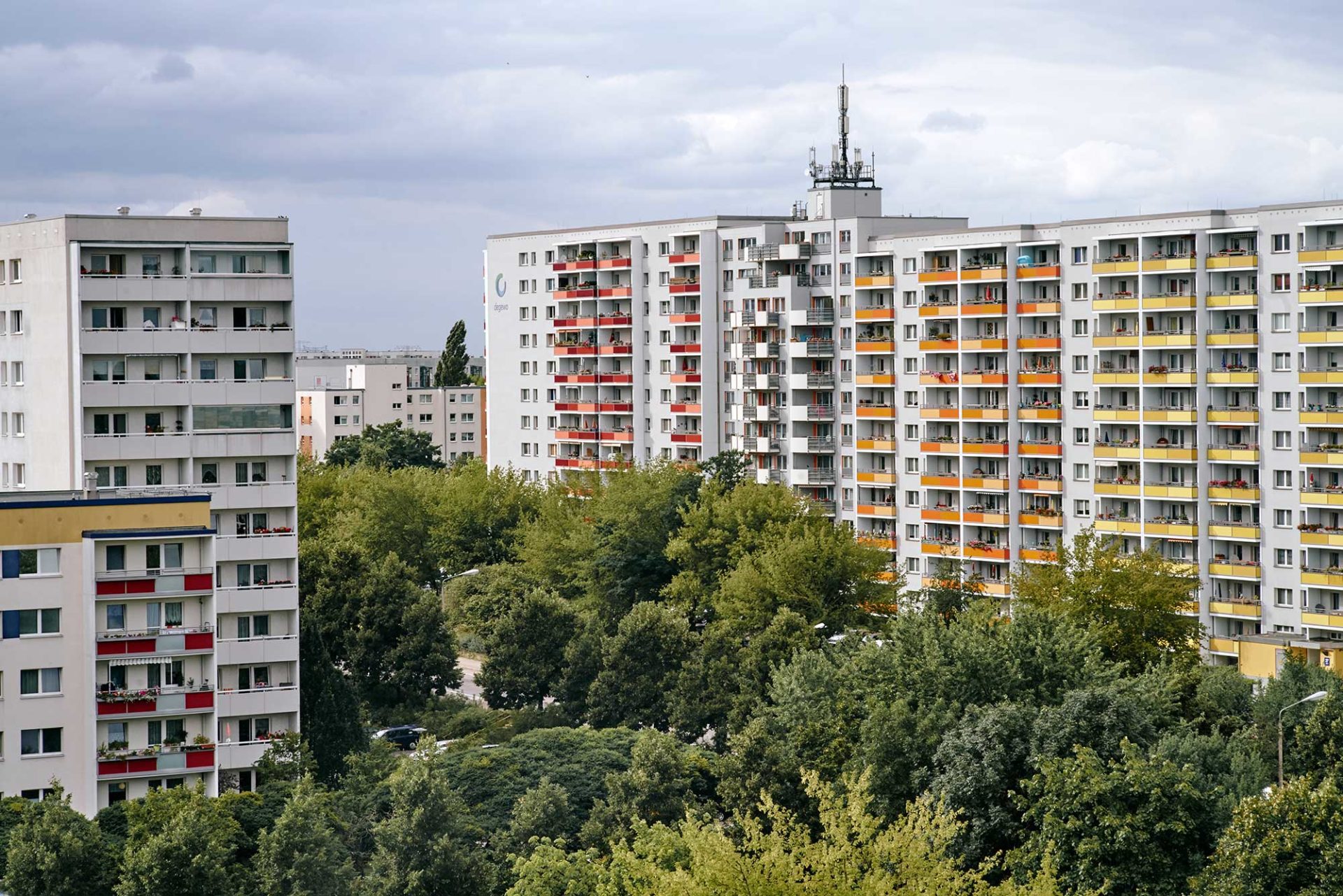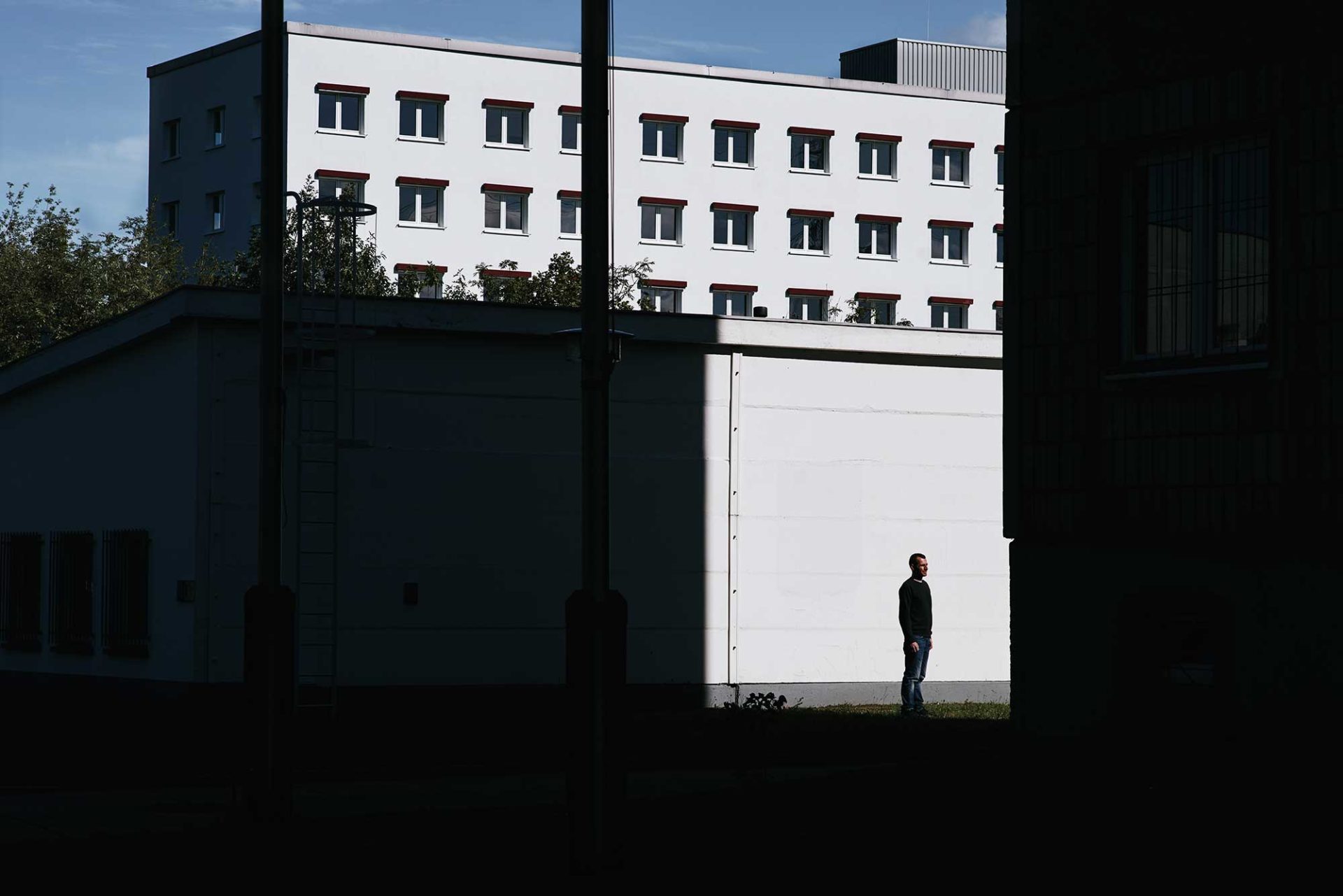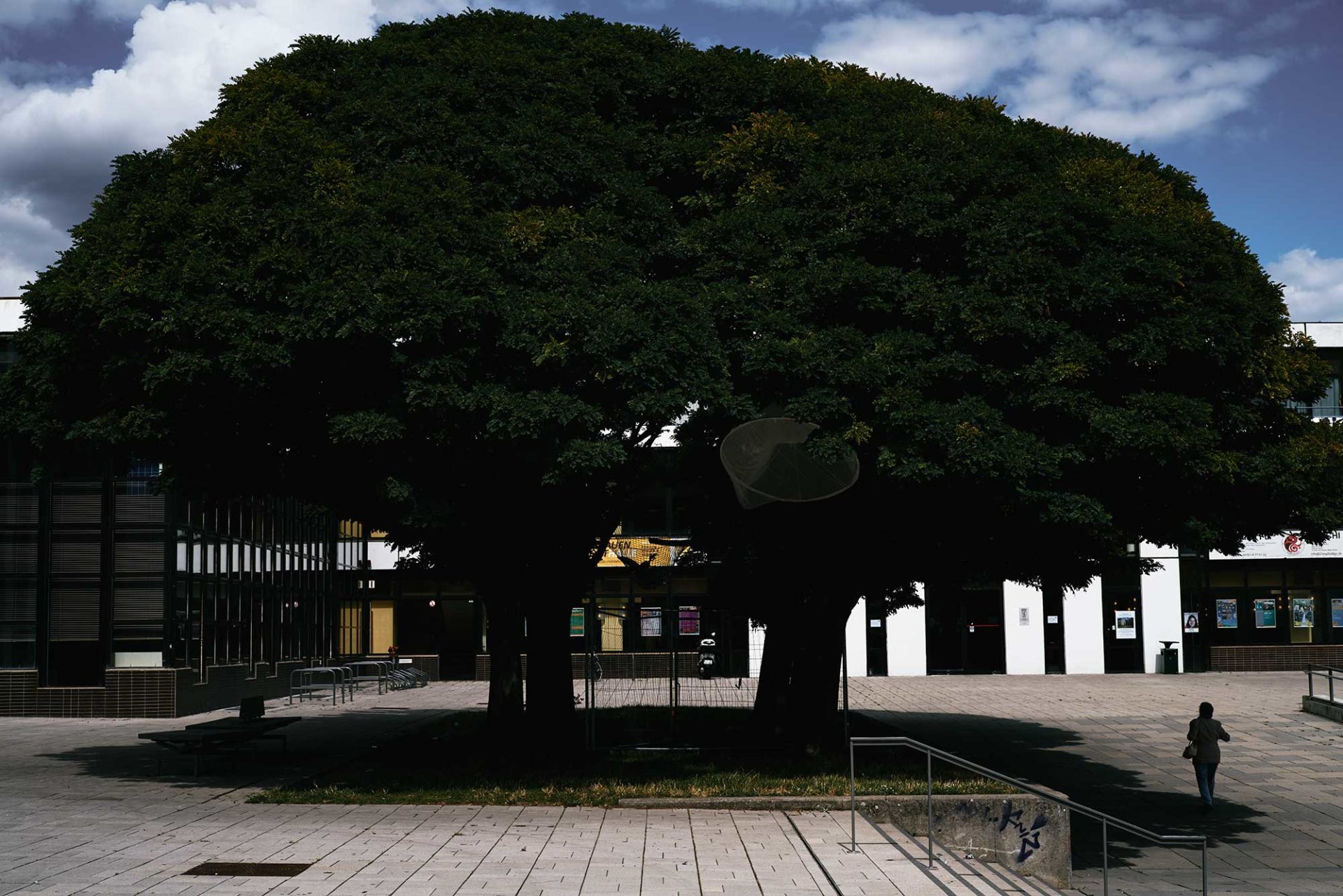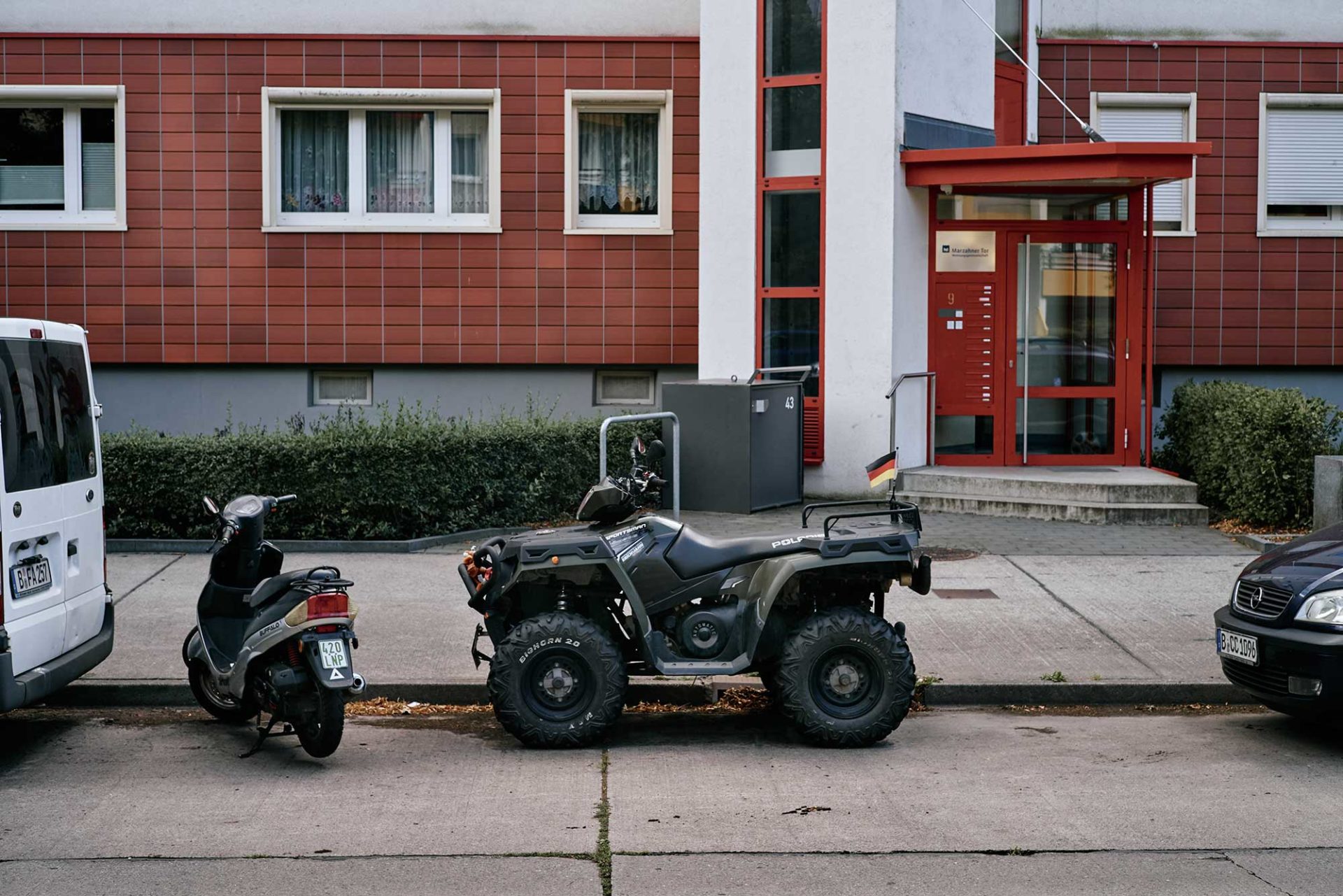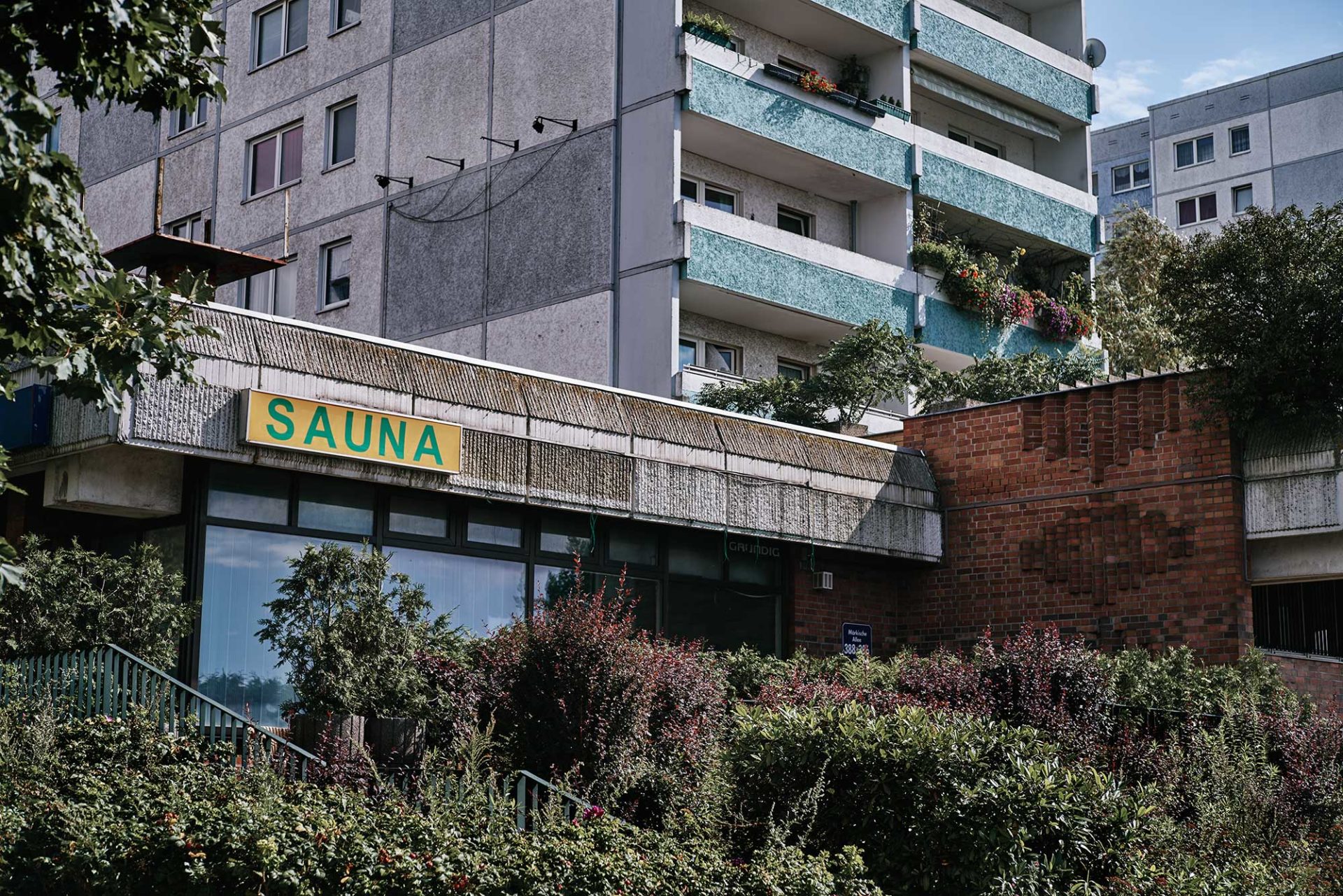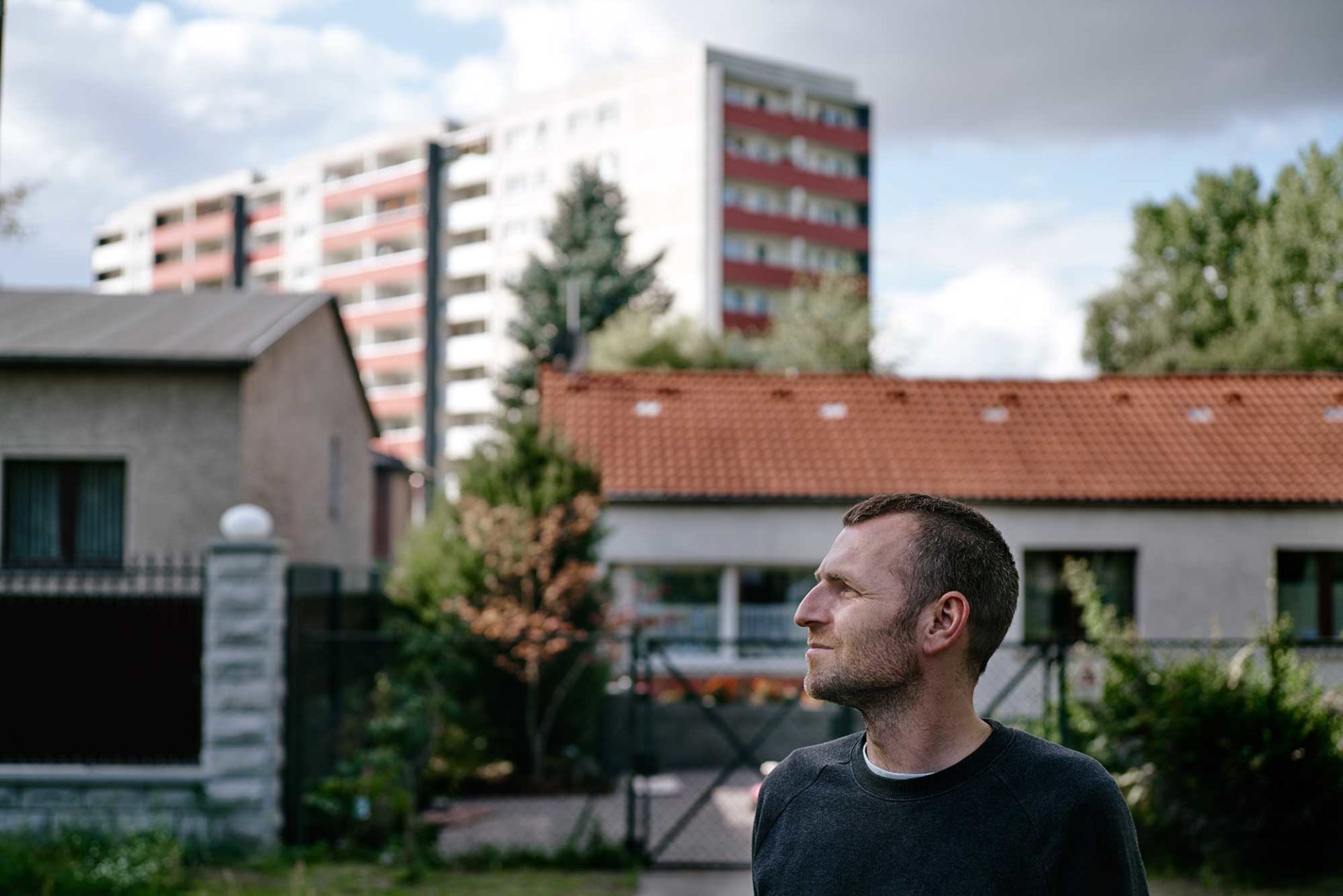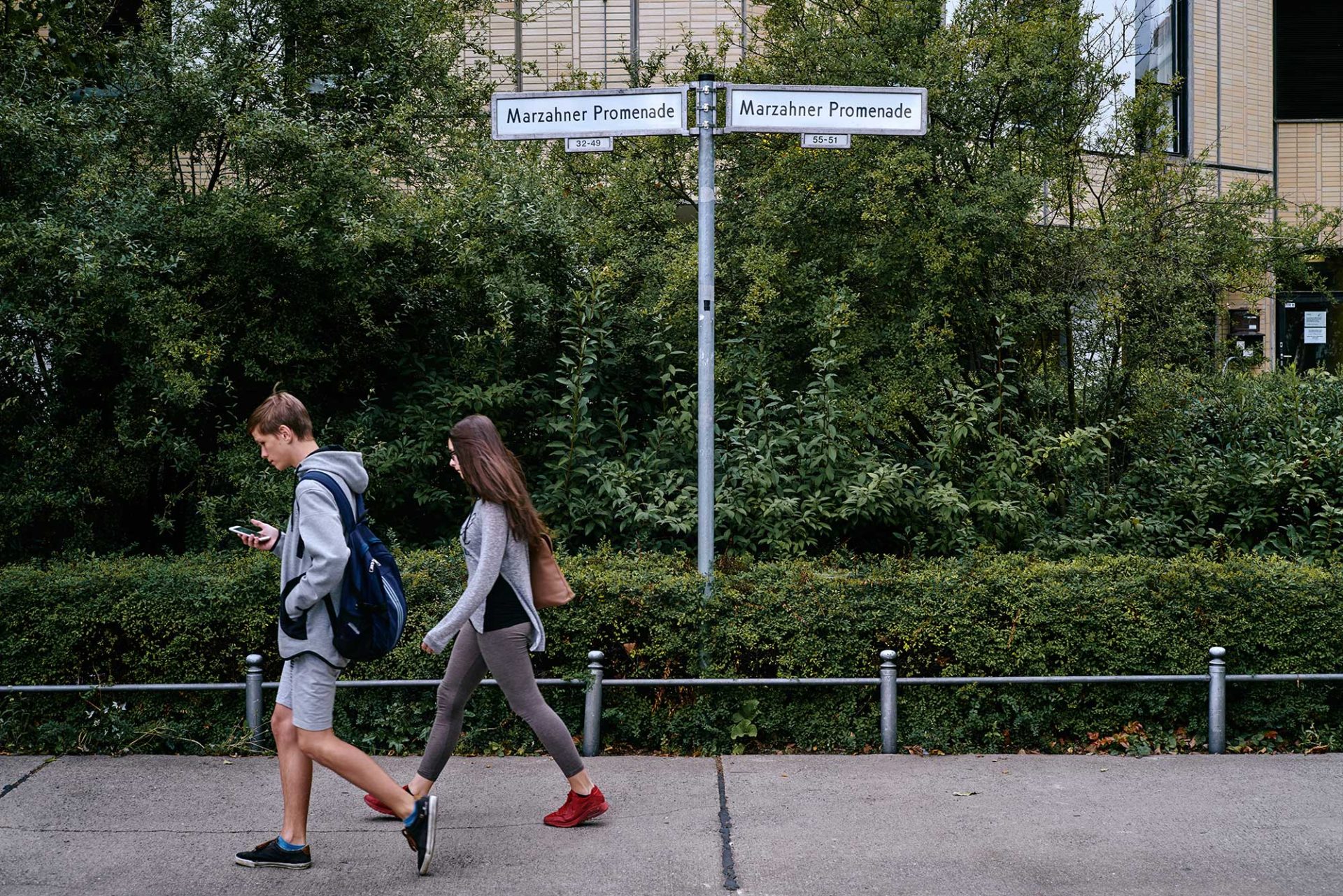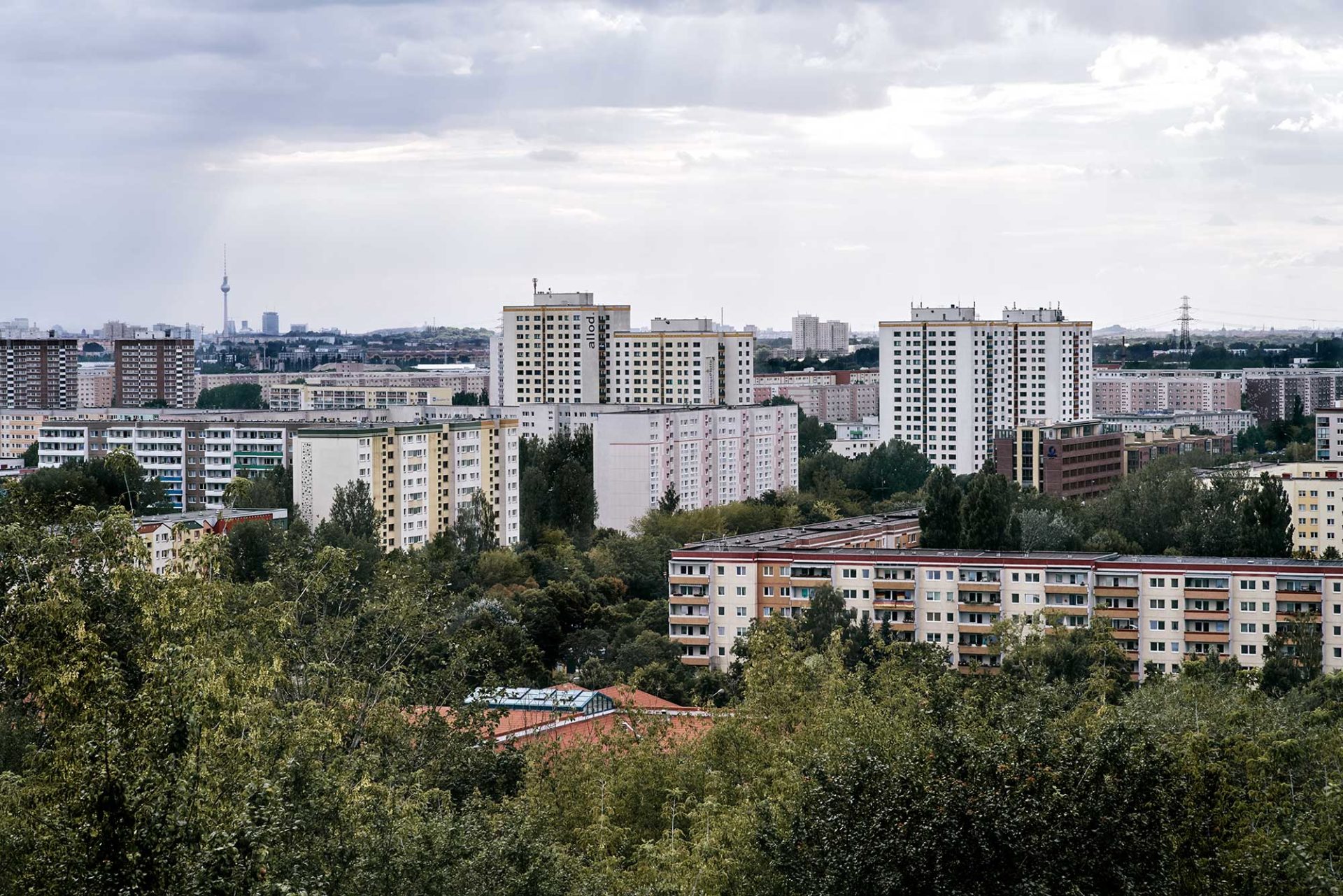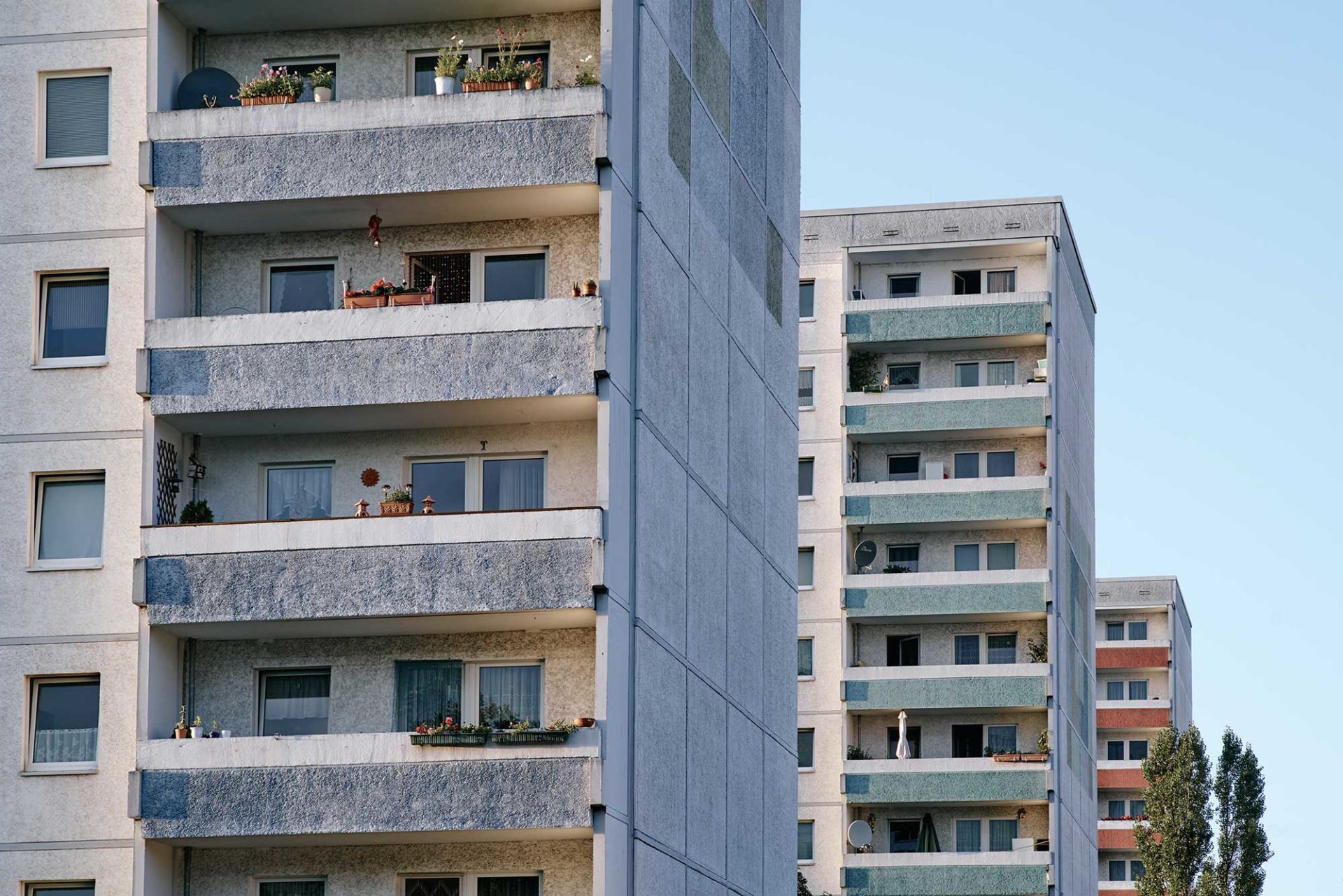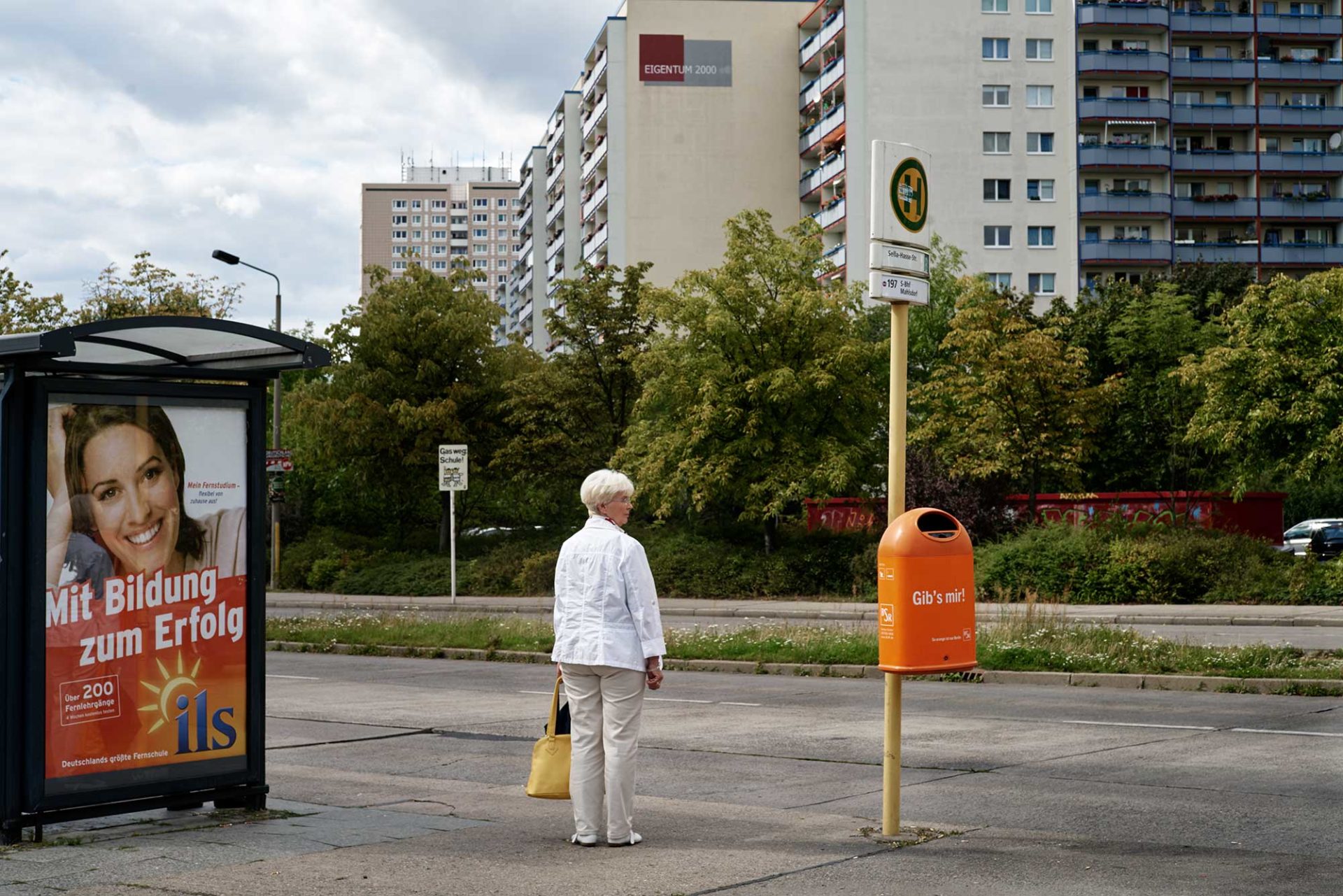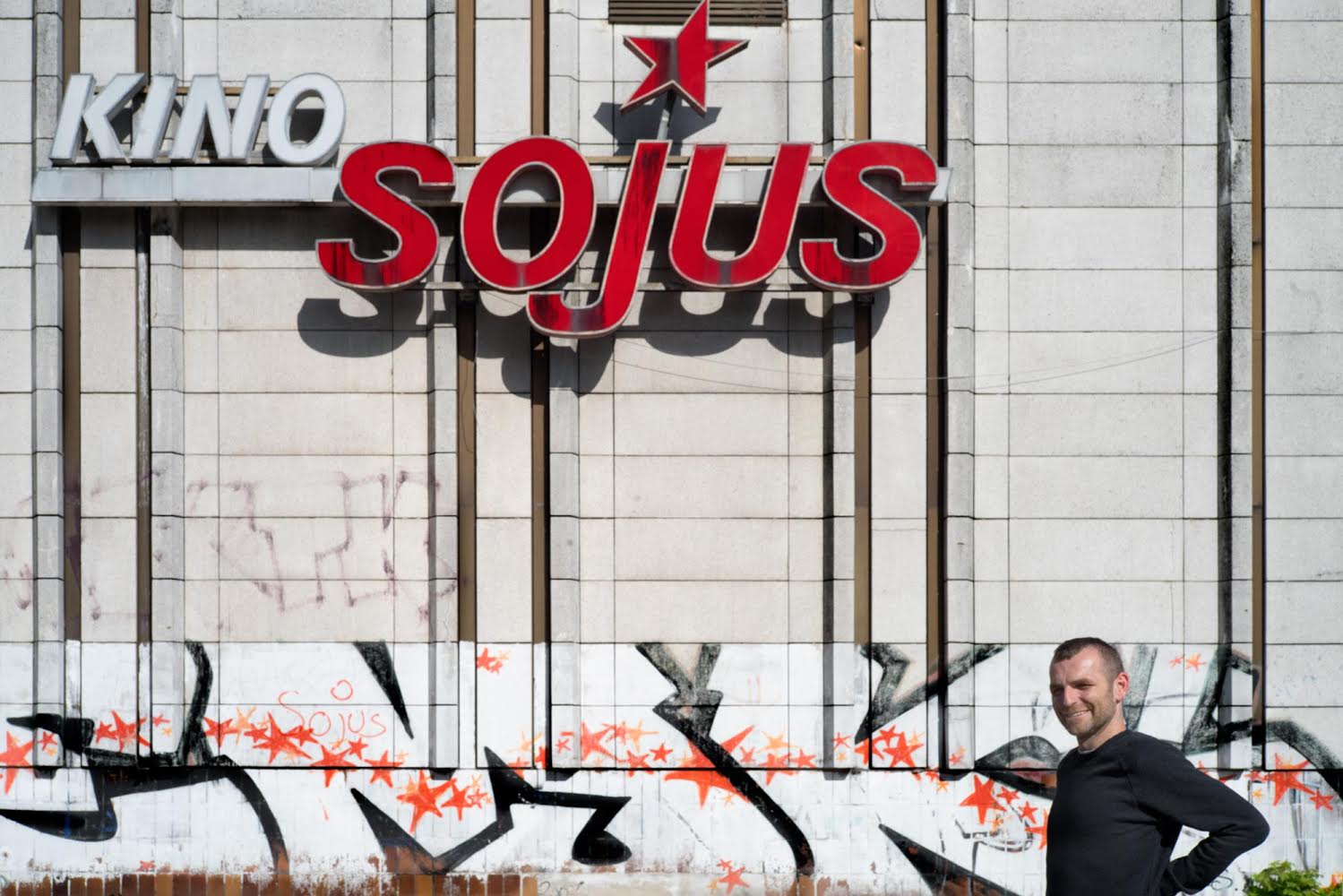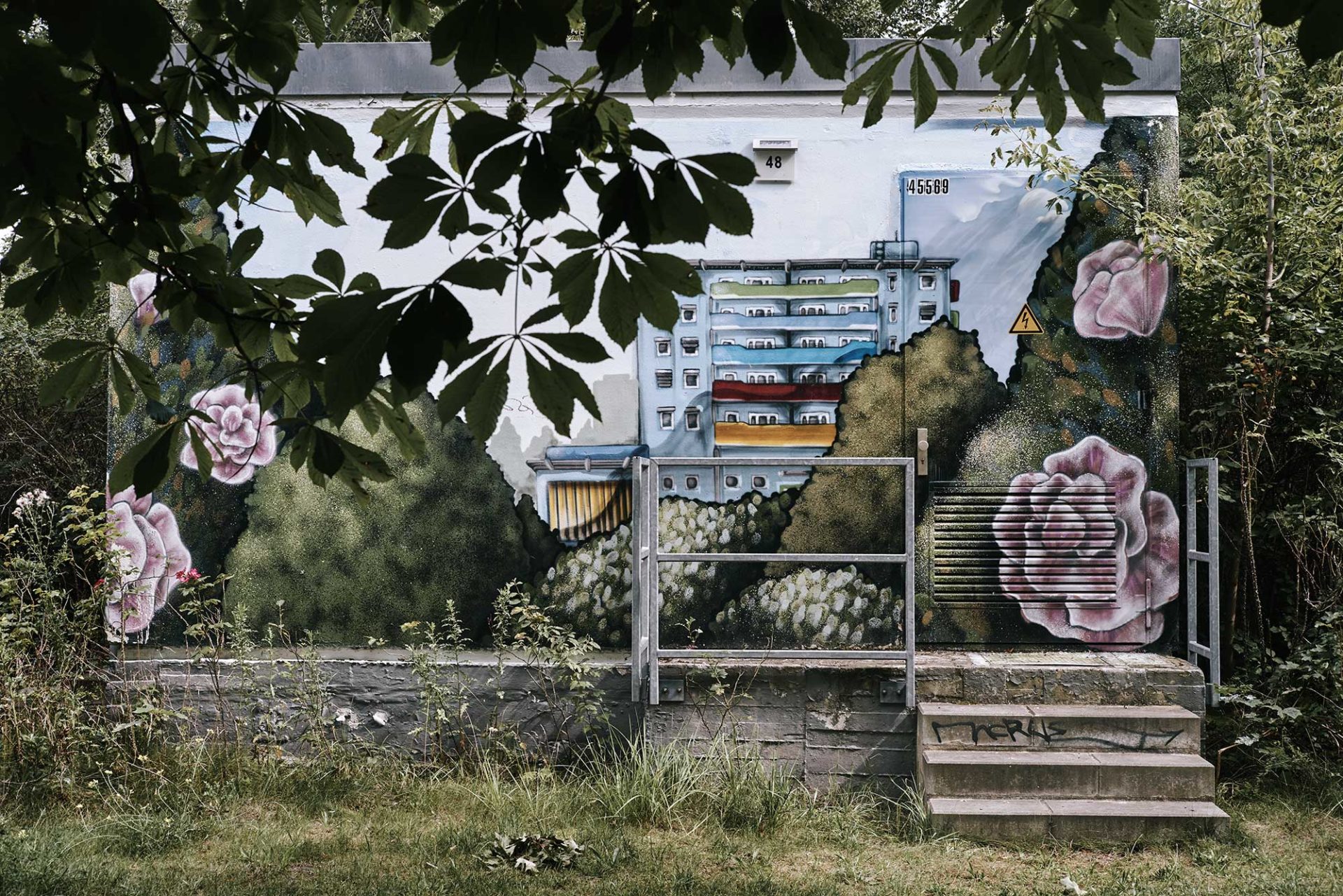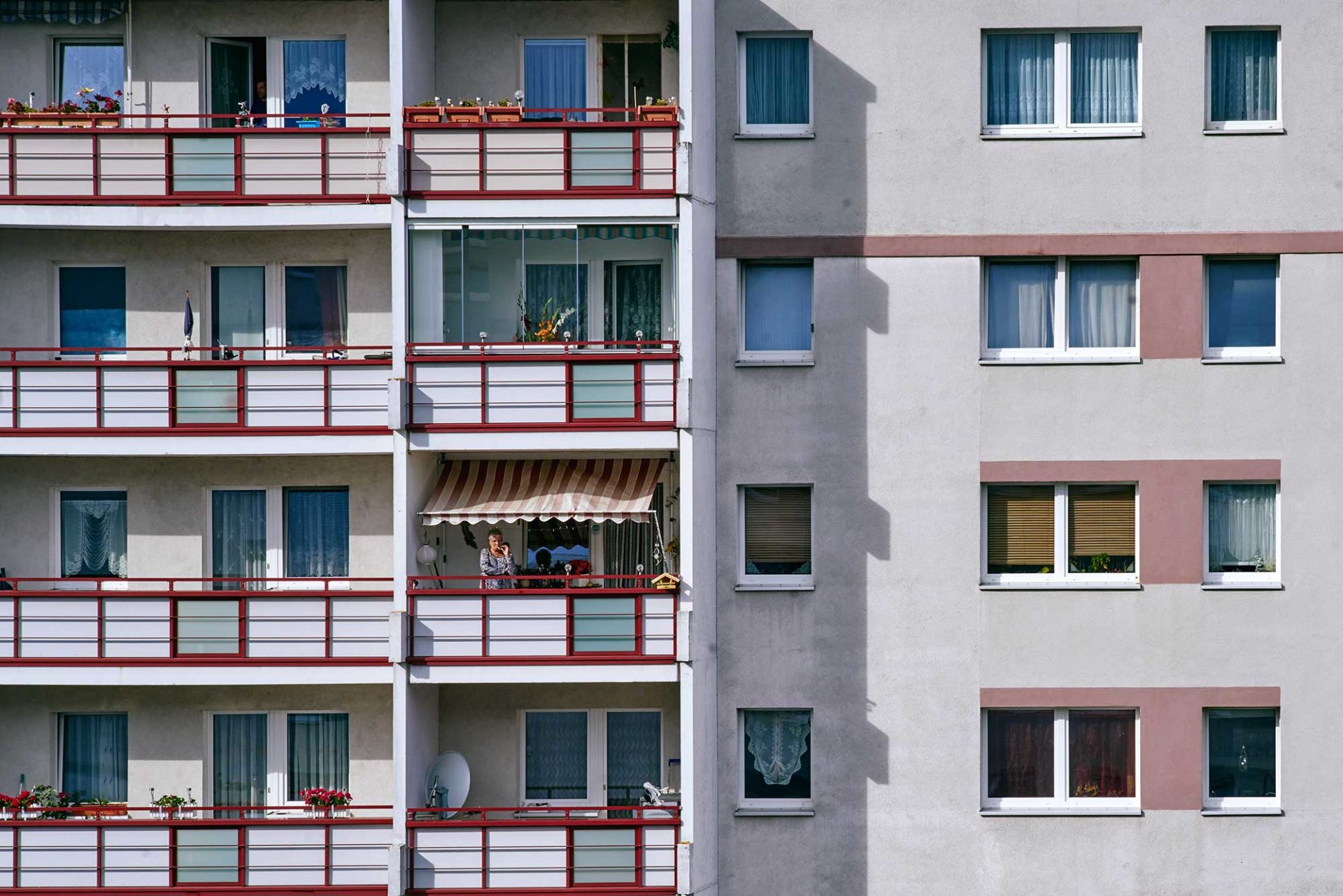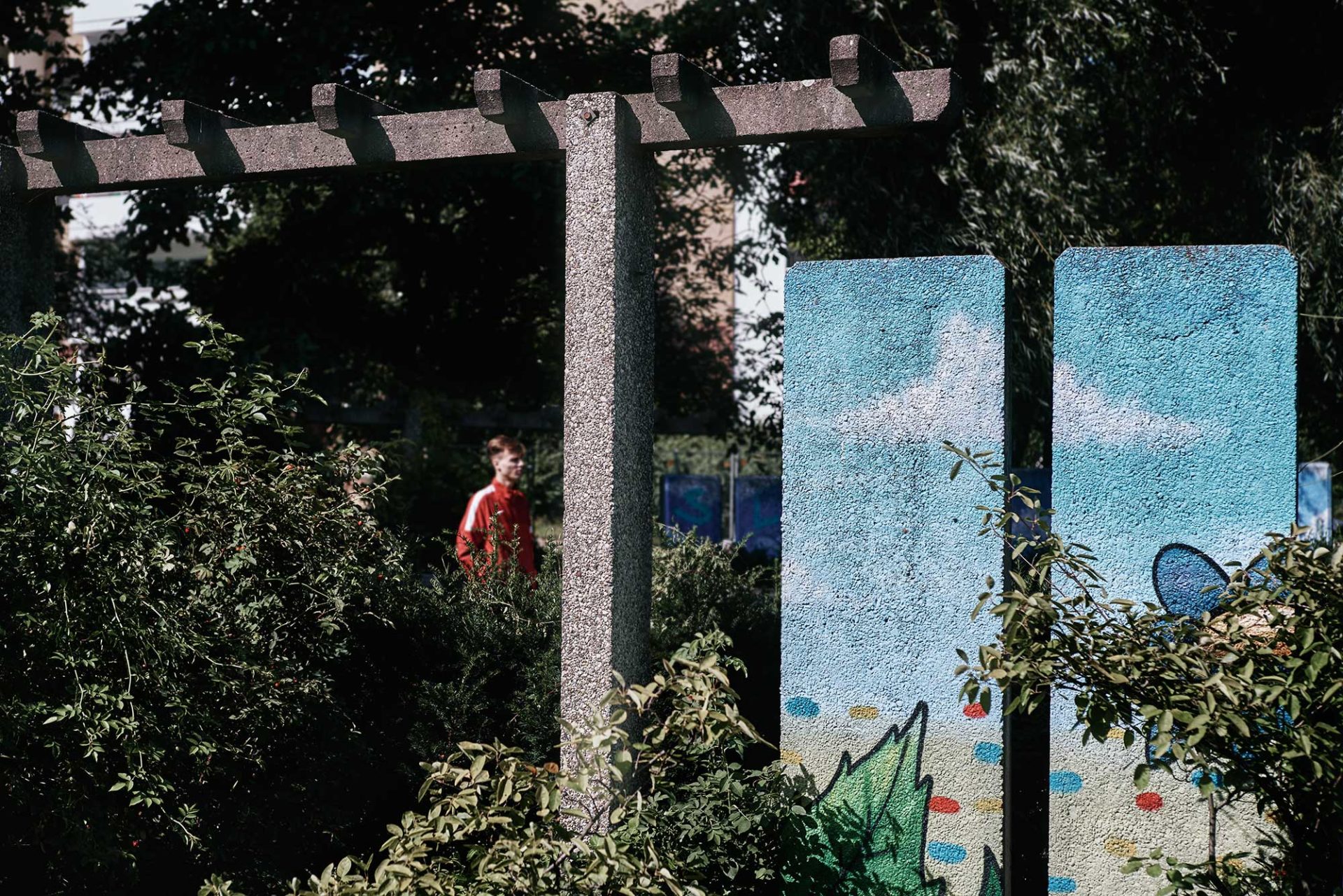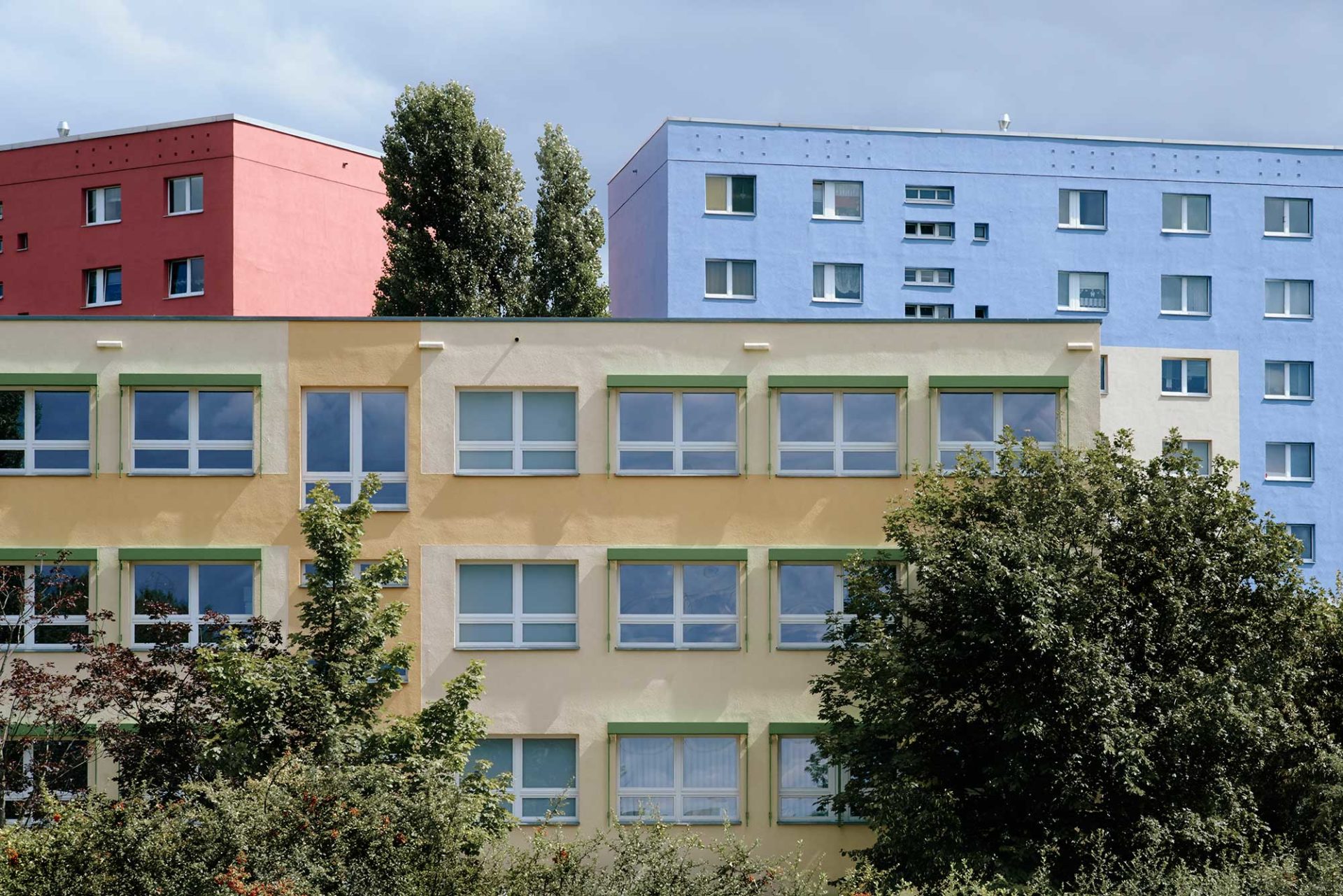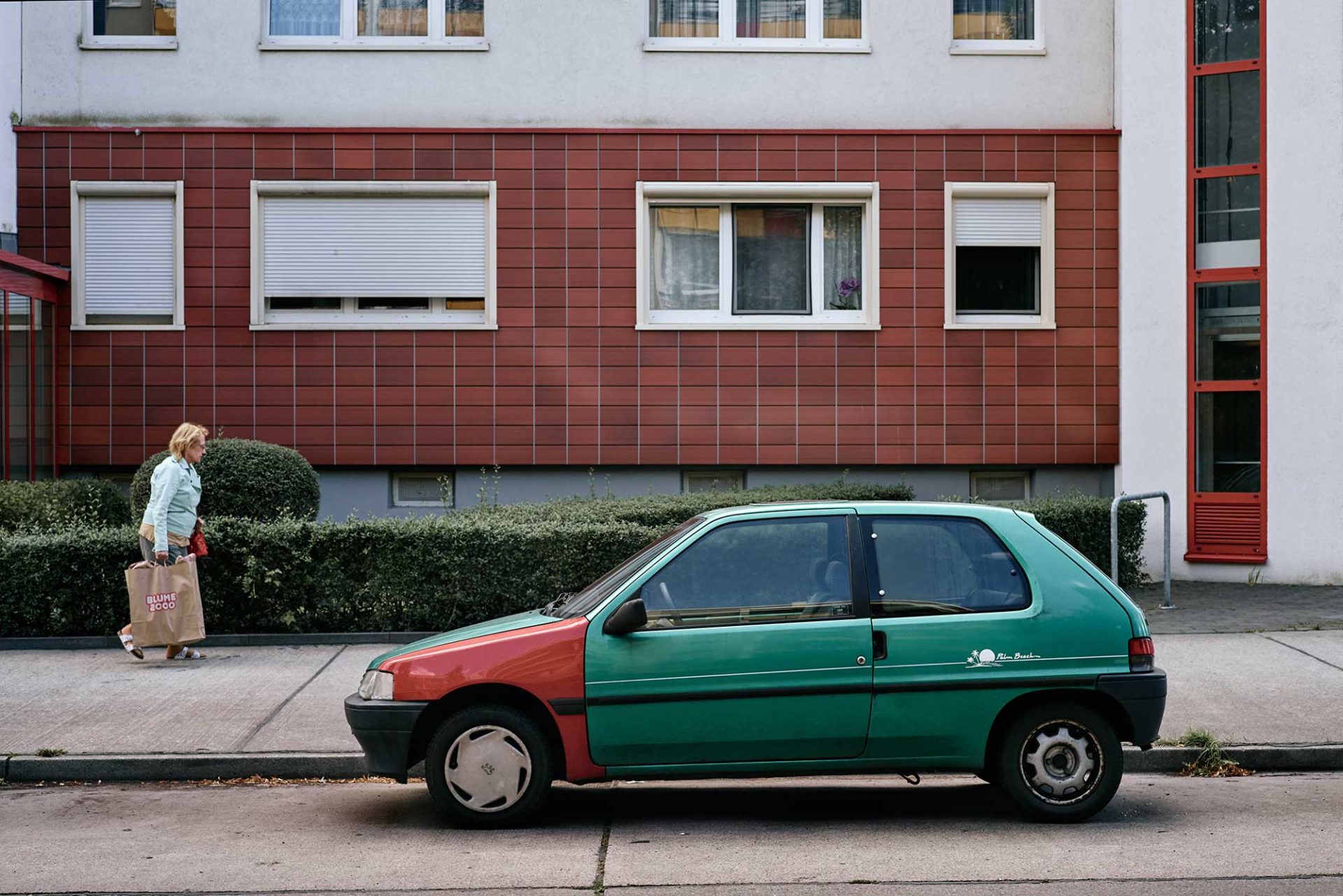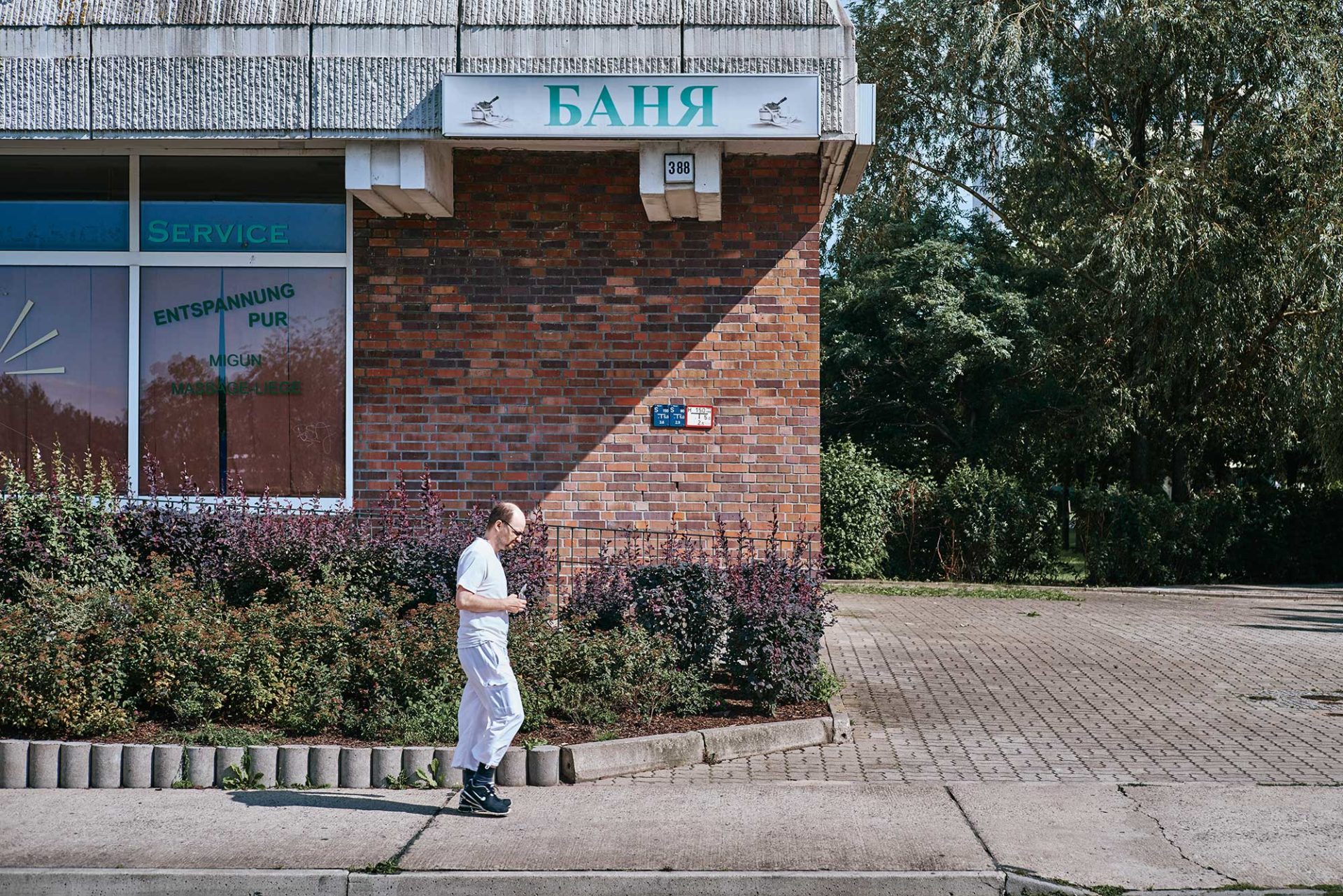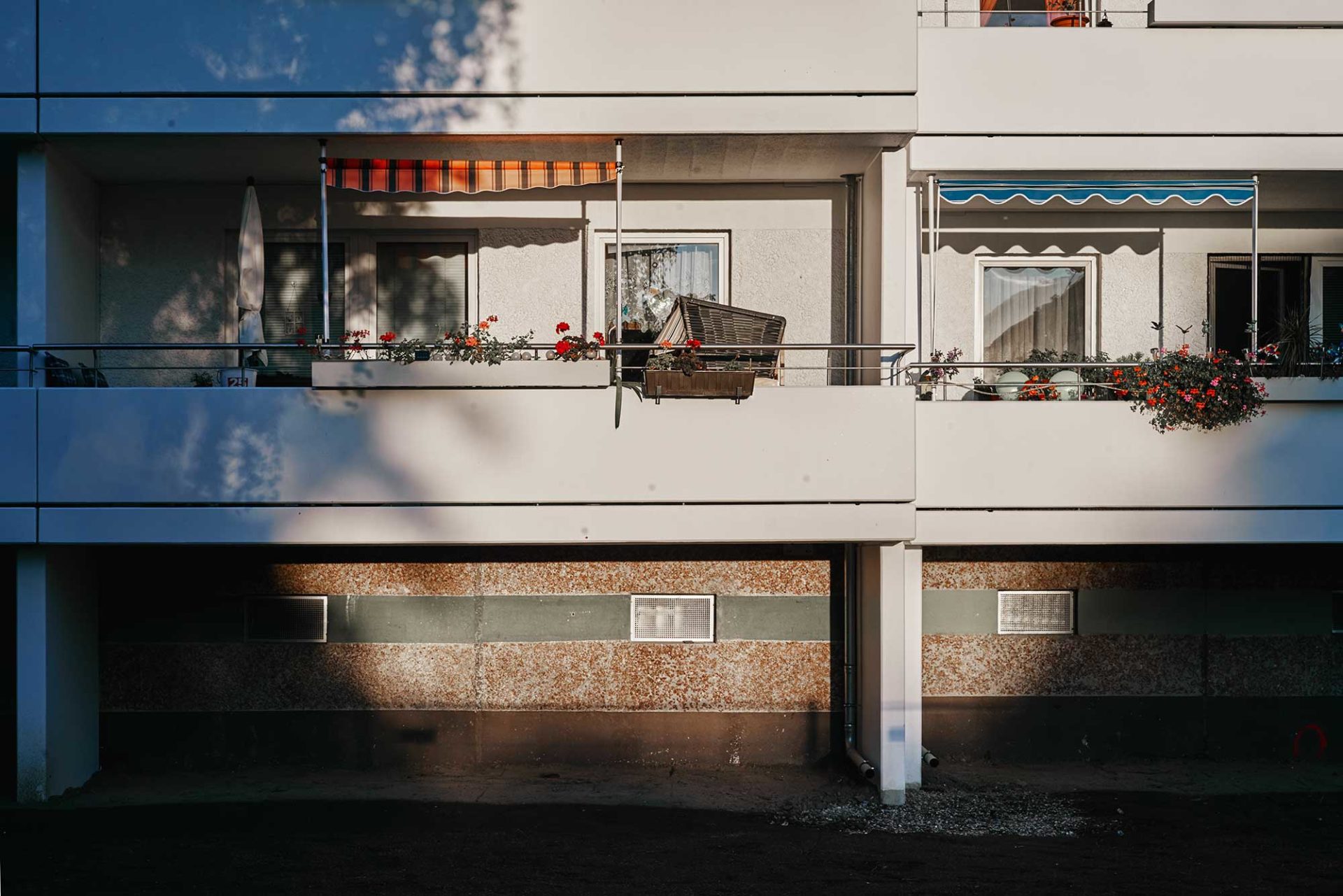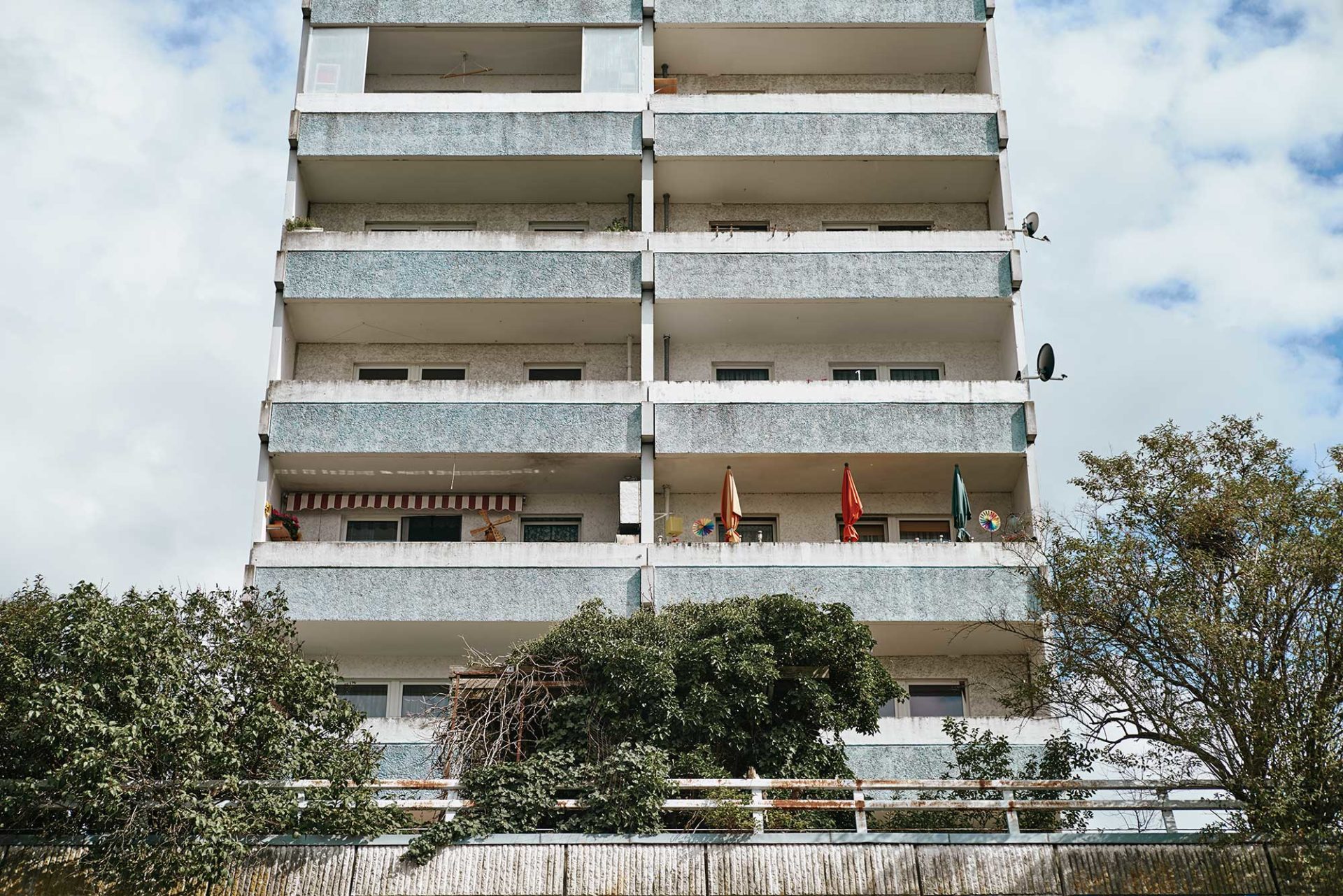“People think it’s a no-go zone,” says our guide while he drives us around Marzahn, a district on the north-eastern border of Berlin. It’s a sunny August afternoon and we’re about 15 kilometres from Alexanderplatz, being driven around in the Volkswagen Polo of a 40-year-old Mohawk-sporting Englishman, who is showing us around the area in which he lives. It’s an incredibly green and spacious scene, people are walking their dogs, and we hear the excited shouts of the many kids playing outside. And no matter where we look, there’s always a concrete Plattenbau high-rise in the backdrop. There are dozens and dozens of them, many of which have recently been renovated, dressed in fresh colours and looking crisp in the lush summer landscape.
Our guide is Mark Hawkins, better known as Marquis Hawkes, a DJ and a producer of soulful, club-ready house music. Having made music and DJ’d under different aliases since the nineties, he adopted his current pseudonym several years ago. In June, Marquis Hawkes’ debut album Social Housing dropped, an album inspired by the socialist housing estates of Marzahn, where he and his family moved four years ago. “Living in one of the poorest parts of Berlin had an effect on the sound of my album,” Hawkins says. “The backdrop of having people leading tough lives around me, alongside our own everyday struggle just to keep the bills paid and food on the table, it has that influence.” While he speeds his car through the sea of high-rises, we talk about living in Marzahn, housing policies, and how he relates to the scene in Berlin’s popular areas.
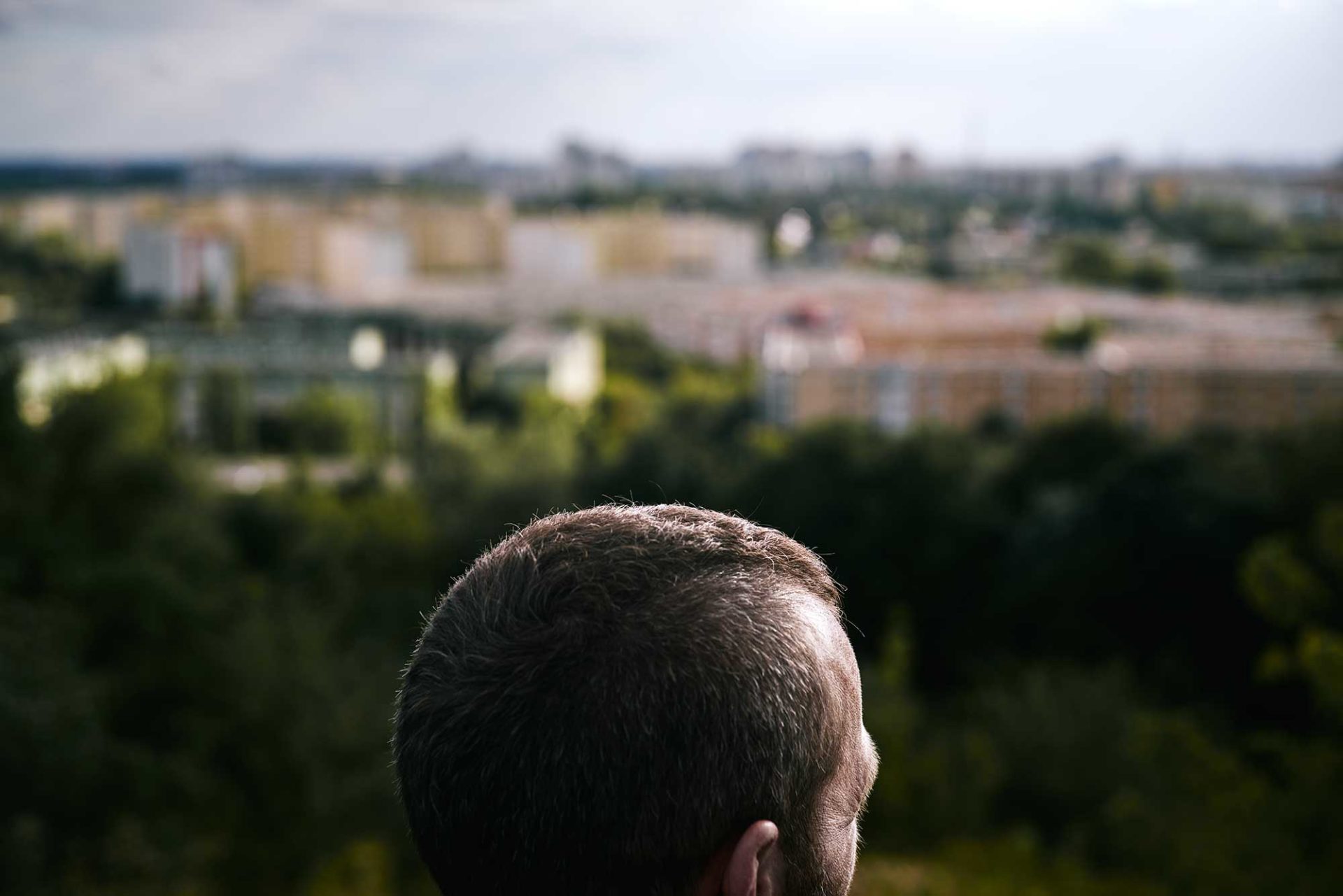
All photos:
© Jur Oster
Arriving in Marzahn earlier that day, just before getting out on the final stop of the S-Bahn train to Ahrensfelde, we overheard people around us talking Russian. Marzahn has the largest concentration of Russians in Berlin, but the number of people speaking Russian is even higher. While almost 90 per cent of the area statistically consists of ‘ethnic Germans’, some 15 per cent of these Germans are in fact repatriates, whose families had been living in Eastern Europe during Soviet times, and who moved back to Germany after the Soviet Union collapsed. Often, still, these returnees speak Russian, and are referred to by other Germans as Russians. “I’ve learned some basic Russian here,” says Hawkins, who says “hello” and “thanks” to the people at the Russian supermarket in their mother tongue. “Half of the teachers in my daughter’s kindergarten speak Russian. And with these buildings around you, sometimes you feel like you’re in Russia.”
When the DDR was formed in 1949, Marzahn became part of East Berlin. Before that, from 1936 to 1943 a Roma concentration camp was located here under Nazi rule. It wasn’t until about thirty years ago that the mostly rural area came to look as it does today. From the late 1970s through the late 80s a massive socialist Plattenbau housing scheme was rolled out (almost twice the size of Amsterdam’s notorious Bijlmermeer project and the largest in the DDR). At the time it was the architectural future, meant to liberate East Berliners from shabby homes, coal stoves and multiple-family shared toilets. In Marzahn, the privileged of the DDR could come to live the modern ‘socialist way of life’. During the last days of German socialism, some 170,000 people lived here. Currently the number is around 100,000.
To outsiders, the area doesn’t have a rosy reputation. A browse around the Internet brings up associations like “bleak”, “social problems”, “neo-Nazi” and even “Vietnamese mafia” (the district also houses the city’s largest aggregations of Vietnamese and Kazakh people). Many Berliners, however, have never really been to Marzahn. Noticing that the area possibly has the city’s highest density of German flags, which adorn everything from cars and balconies to children’s bikes, we touch upon the neo-Nazi reference. “There was a demonstration of some far-right nut jobs last night”, says Hawkins, “but most people I know here aren’t interested in all that.”
After dropping by the building where the characteristically quick-witted Briton makes his music (a straightforward DDR office block transformed into a hub of recording and rehearsal studios), our conversation moves to the neglect of social housing estates in European countries. Hawkins, having been born in London and having lived in state-owned flats during his childhood, says: “I always thought the way it was originally envisaged, at least as it was in post-war Britain, was a great policy; invest some money, and you’ll get people working and get people housed. This continued pretty well into the early 70s, which is where mismanagement started cropping up, and then into the 80s when Thatcher and others in the conservative government decided it didn’t really fit into their worldview, of survival of the fittest in a capitalist society. And that’s when it became run down, on purpose I think.”
The selling of social housing and the promotion of home-ownership has been happening throughout Europe ever since, perhaps most feverishly in the United Kingdom through its infamous Right to Buy scheme. It increasingly changed the nature of the home from a place to live into a commodity. Hawkins thinks UK governments have deliberately left social housing behind. “It seems to me that they just cut the investment going into these estates and tried to wash their hands of any responsibility for them. The sting in the tail was blaming the failure of the concept on the architecture. For conservative governments, blaming it on the architecture was a great way of diverting attention away from the fact that it was their fault, that they had caused it to get like that.” The remaining social housing, he says, had gone from housing intended for everyone, “to housing for the people in society with the most problems. So you throw a load of families with kids with behavioural problems in one place, and of course, no one else is going to want to live there.”
Marzahn is not unlike that, Hawkins explains: “our particular corner of Marzahn does seem to be the dumping ground, for the desperate, for the people who have nowhere else to go, and the housing association seemed pretty keen to put us in this area.” He and his wife didn’t question it at the time, as they just wanted a roof over their heads. “We were in a tight spot, and it was the only viable option. But as time has gone by, we’ve noticed that the levels of education, of parenting, of care for disabled people in the area could be much, much higher.”
“Where we are is possibly one of the most deprived areas of Berlin,” says Hawkins, who wants to stay in the city but is also looking to move out of Marzahn at some point. “The way people are bringing their kids up, smoking heavily, drinking heavily, is at a point where I don’t want my daughter growing up surrounded by that any longer than I have to. But that said, if this is as bad as it gets, then I don’t think we’re living in such a bad society, all in all.” He thinks Marzahn is nowhere near as bad as some of the areas in London or Nottingham where he’s lived previously: “if these are the worst estates around.. If you visit the worst in the UK you’d see guys dealing drugs on the street.”
Marzahn has a different atmosphere. Statistically, the area even has one of the lowest crime rates in Berlin. It comes across as a decent, well-maintained area with good amenities and a lot of eyes on the street. While I did notice three stumbling drunks over the three days we visited, the striking number of families and elderly people lounging about on weekdays – even considering the good weather – completely dominated the scene, resulting in an overall friendly vibe. When asked what he appreciates about Marzahn, Hawkins says: “there are a lot of plusses. It’s very, very green, there’s loads of playgrounds for kids, good access to child care facilities like kindergartens, and the rent is the cheapest in the city, which as an artist, gives you considerable breathing space to develop.”
Cheap rent is something increasingly rare in Berlin, especially in its popular areas, where monthly rates are soaring and long-time residents, shops and community cornerstones are being pushed out. Such districts, like Kreuzberg or Neukölln, are the preferred habitats of the young and hip. Over there, Berlin’s (aspiring) creatives and the AirBnB-ing Easyjet herds cluster. It’s where you can satisfy your globalised taste for an aesthetic and culture that is by now fairly mainstream. You’ll also be able to spot someone close to the archetypical hipster within a minute. In Marzahn, you don’t see them.
Having a different lifestyle at 40 – “I have a family at home and don’t drink or really party anymore” – Hawkins doesn’t miss the atmosphere of Berlin’s fashionable neighbourhoods, which sometimes feel to him like isolated bubbles filled with young foreigners. “It definitely pains me to see people come over and not bother to learn the language. I think there is a big danger, if you move to a city like Berlin, surround yourself with other ‘expats’ and stay within the confines of only a few similar areas, that you don’t really see the true city. But I tend to find those are the people that are only here temporarily.”
He’s happy to live in one of Berlin’s more “normal” areas. “I appreciate the fact that living where I live made me up my game with my German language skills. I never hear any languages on the street here other than German, Russian and Vietnamese. Polish or Latvian perhaps, my wife is Lithuanian, but no English at all. This is why I say, I’m not an expat – I’m an immigrant.” He doesn’t hang about much with people from his country of birth. “These days I’m feeling much more of a kinship to German cultural values than British ones.”
Enjoying a peaceful life in Marzahn when he’s not on the road, Hawkins only tends to go to the more trendy areas on a need-to-go basis. “I dip in and out of what’s going on there, to go record shopping, have meetings and meet with friends. Not getting many visitors up here also has its benefits. I have my studio also in Marzahn, and I can maintain much more focus than if I had people dropping by all the time.”
How do people respond when he says he lives in Marzahn, I ask. Hawkins laughs: “shock, usually! It’s not the most typical place for anyone in the more creative realm to live, although that might well change if rents keep rising in the rest of the city the way they are right now.” He jokes that by the time the area’s gentrification is in full swing, he wants to have turned Kino Sojus, Marzahn’s ruined DDR cinema, into a club.
All photos are courtesy of Jur Oster.

